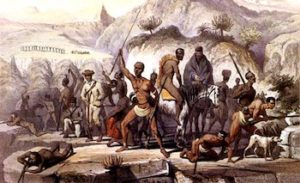
Xhosa War depiction (1851)
*On this date in 1789, we affirm the Xhosa Wars. Also known as the Cape Frontier Wars or the Kaffir Wars, they were a series of nine wars or outbreaks between the Xhosa Kingdom and white European slave traders in what is now the Eastern Cape in South Africa.
These war incidents were the longest-running military action in the history of African colonialism. The first Europeans in the Cape were the Dutch, who established a small supply station in 1652 at present-day Cape Town for their trading ships to stop for supplies en route to and from the East Indies and Nagasaki of Japan. European settlement in and around Cape Town later spread into the valleys. By the second half of the 18th century, white Europeans moved eastward up the coast and encountered the Xhosa in the region of the Great Fish River.
The Xhosa were already established in the area and herded cattle. Competition for land ensued after several groups of British colonizers arrived in 1820. The Europeans invaded using force when the land they had initially seized restricted them from expanding their stock farming activities. The Dutch East India Company founded several urban areas, like towns and cities in already populated areas west of South Africa, continually changing the boundaries in the Cape Colony, establishing the Great Fish River as the eastern frontier in 1778.
The reality of the almost 100 years of conflicts between the white Europeans and Xhosa involves a balance of tension. At times, tensions existed between the various Europeans in the Cape region, between Empire administration and colonial governments, and tensions within the Xhosa Kingdom, e.g., chiefs rivaling each other, which usually led to Europeans taking advantage of the situation to meddle in Xhosa politics. A perfect example is the case of Chief Ngqika and his uncle, Chief Ndlambe.